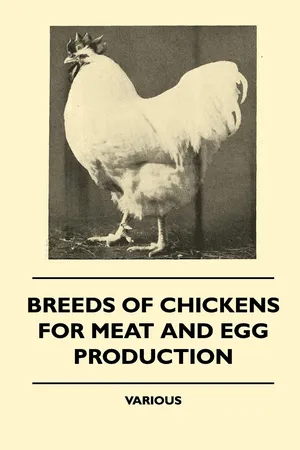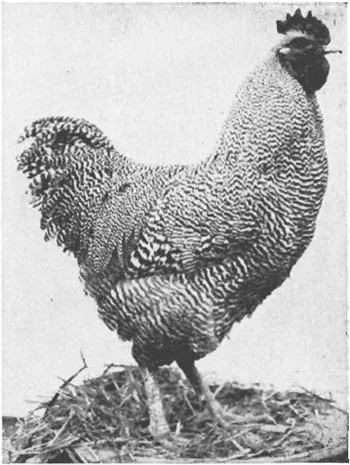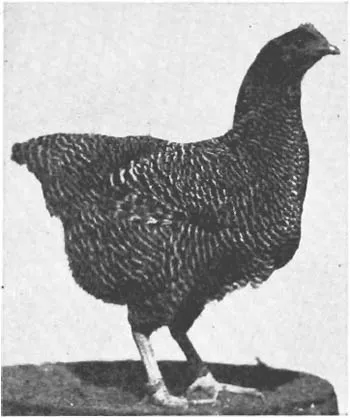
- 34 pages
- English
- ePUB (mobile friendly)
- Available on iOS & Android
eBook - ePub
Breeds of Chickens for Meat and Egg Production
About this book
This vintage book contains a comprehensive guide to the variety of breeds of poultry commonly used for meat and eggs. For each breed treated there is provided a photograph accompanied by a detailed description and other notable information. "Breeds of Chickens for Meat and Egg Production" will be of utility to modern farmers and keepers of poultry alike, and it would make for a useful addition to related collections. Contents include: "Poultry Farming", "Breeds of Chickens for Meat and Egg Production", "Introduction", "American Class", "Asiatic Class", "English Class", and "Mediterranean Class". Many vintage books such as this are increasingly scarce and expensive. It is with this in mind that we are republishing this volume now in an affordable, modern, high-quality edition complete with a specially-commissioned new introduction on poultry farming.
Frequently asked questions
Yes, you can cancel anytime from the Subscription tab in your account settings on the Perlego website. Your subscription will stay active until the end of your current billing period. Learn how to cancel your subscription.
At the moment all of our mobile-responsive ePub books are available to download via the app. Most of our PDFs are also available to download and we're working on making the final remaining ones downloadable now. Learn more here.
Perlego offers two plans: Essential and Complete
- Essential is ideal for learners and professionals who enjoy exploring a wide range of subjects. Access the Essential Library with 800,000+ trusted titles and best-sellers across business, personal growth, and the humanities. Includes unlimited reading time and Standard Read Aloud voice.
- Complete: Perfect for advanced learners and researchers needing full, unrestricted access. Unlock 1.4M+ books across hundreds of subjects, including academic and specialized titles. The Complete Plan also includes advanced features like Premium Read Aloud and Research Assistant.
We are an online textbook subscription service, where you can get access to an entire online library for less than the price of a single book per month. With over 1 million books across 1000+ topics, we’ve got you covered! Learn more here.
Look out for the read-aloud symbol on your next book to see if you can listen to it. The read-aloud tool reads text aloud for you, highlighting the text as it is being read. You can pause it, speed it up and slow it down. Learn more here.
Yes! You can use the Perlego app on both iOS or Android devices to read anytime, anywhere — even offline. Perfect for commutes or when you’re on the go.
Please note we cannot support devices running on iOS 13 and Android 7 or earlier. Learn more about using the app.
Please note we cannot support devices running on iOS 13 and Android 7 or earlier. Learn more about using the app.
Yes, you can access Breeds of Chickens for Meat and Egg Production by Various Authors in PDF and/or ePUB format, as well as other popular books in Technology & Engineering & Zoology. We have over one million books available in our catalogue for you to explore.
Information
AMERICAN CLASS
The American class includes the following breeds and varieties:
| Breed | Variety |
| Plymouth Rock | Barred, White, Buff, Silver-Penciled, Partridge, Columbian, Blue. |
| Plymouth Rock Bantam | Barred, White |
| Wyandotte | White, Buff, Silver-Laced, Golden-Laced, Partridge, Silver-Penciled, Columbian, Black. |
| Wyandotte Bantam | White, Black, Buff, Partridge, Silver-Penciled, Columbian, Silver-Laced. |
| Rhode Island Red | Single Comb, Rose Comb. |
| Rhode Island Red Bantam | Single Comb, Rose Comb. |
| Rhode Island White | Rose Comb |
| New Hampshire. | |
| Jersey Giant | White, Black. |
| Java | Black, Mottled. |
| Dominique. | |
| Chantecler | White, Partridge. |
| Lamona. | |
| Buckeye. | |
| Holland | Barred, White. |
| Delaware. |
All birds belonging to the American class are clean legged; that is, they have shanks free from feathers. They also have red ear lobes, and all lay brown-shelled eggs, except the Lamonas and Hollands which produce white-shelled eggs.
Plymouth Rock
The Plymouth Rock is one of the most popular breeds in the United States, largely because it is a bird of good size, with excellent fleshing properties, and when properly bred is also a good layer. The birds belonging to this breed are rather long bodied, fairly broad, with a prominent breast and good depth of body. This breed has a single comb. The standard weights in pounds are: cock, 9 1/2; hen, 7 1/2; cockerel, 8; pullet, 6.

3197–C
Figure 2.—Barred Plymouth Rock, male.
The Barred Plymouth Rock in plumage color is grayish white, each feather crossed by sharply defined dark bars which should be even in width, straight, and extend down to the skin. The light and dark bars of the male are of approximately equal width; in the female the light bars are approximately one-half the width of the dark bars. Each feather should end with a narrow, dark tip, which, with the alternate dark and light bars, gives a bluish cast or shade, to the surface color. The barring in the hackle and saddle of the male is narrower than in other sections. Solid black or partly black feathers may occur in practically all strains in this variety, but their appearance does not necessarily indicate impurity of breeding. Two or more solid-black primaries, or secondaries, or main tail feathers are standard disqualifications. The shanks and beak are yellow.

19305–B
Figure 3.—Barred Plymouth Rock, female. Note that the black bars on the feathers are about twice as wide as the light bars.
There is a decided tendency for Barred Plymouth Rock males to come lighter in color than the females. In order to produce standard-color males and females from the same mating, the female must have black bars approximately twice as wide as those of the male.

37791–B
Figure 4.—White Plymouth Rock, male.
The White Plymouth Rock is pure white throughout and should be free from black ticking, brassiness, and creaminess. The beak is yellow and the shanks are rich yellow. This breed was developed from a white sport of the Barred variety.
The Buff Plymouth Rock has a rich golden buff surface color and all sections should be of the same shade. The presence of feathers with shafts of a different color from the rest of the feather and of feathers sprinkled with lighter color are of common occurrence but are undesirable. The undercolor should be as similar to the surface color as possible. The beak is yellow, the shanks rich yellow.
The Silver-Penciled Plymouth Rock has a distinctive color pattern which in the male differs considerably from that of the female. The plumage of the male is silvery-white on the surface over the wing bows and back; the saddle is silvery white striped with black; the hackle is greenish black with a narrow edging of silvery white. The rest of the plumage, including the main tail feathers and sickles, is black or greenish black. The primaries are black, except for a narrow edging of white on the lower edges of the lower webs, and the secondaries are also black, with some white. In the female the general surface color is gray, with a distinct, concentric penciling of dark gray on each feather. The feathers of the front of the neck and the breast are steel gray with distinct black pencilings. The hackle feathers are black, slightly penciled with steel gray, and laced with silvery white. The main tail feathers are black, the two top feathers showing some penciling. The feathers on the back, breast, body, wing bows, and thighs should have three or more pencilings. The undercolor in the male is slate, shading to a lighter color toward the base of each feather. The beak is dusky yellow shading to yellow at the point. The shanks are yellow in the male and yellow or dusky yellow in the female. The color markings of this variety are similar to those of the Silver-Penciled Wyandotte and the Dark Brahma.

33698–B
Figure 5.—Partridge Plymouth Rock, male.
The Partridge Plymouth Rock is practically the same as the Silver-Penciled Plymouth Rock in color pattern, except that the white of the Silver-Penciled is replaced by red or reddish bay. The hackle of the male is lustrous greenish black with a narrow edging of brilliant red; the plumage in front of the neck is black. The wing bow is brilliant red. The primaries are black, with the lower edges reddish bay, and the secondaries are also black, the outside web being reddish bay, with black at the end of each feather. The main tail feathers are black; the coverts lustrous greenish black edged with rich brilliant red. The back has feathers of lustrous greenish black with a narrow lacing of rich brilliant red. Rich brilliant red predominates on the surface of the upper back. In the female the hackle feathers are black, slightly penciled with deep reddish bay and laced with reddish bay, and the front of the neck and breast are both deep reddish bay distinctly penciled with black. The wing bows are also deep reddish bay penciled with black. The primaries are black with deep reddish bay diagonal pencilings on the lower webs, the upper webs of the secondaries are black, and the lower webs are deep reddish bay penciled with black. The back is also deep reddish bay penciled with black. The undercolor of all sections of both sexes should be slate. The beak is dark horn shading to yellow at the point. The shanks of the male are yellow; of the female, yellow or dusky yellow.
The Columbian Pl...
Table of contents
- Cover
- Title
- Contents
- Introduction
- American class:
- Asiatic class:
- English class:
- Mediterranean class: